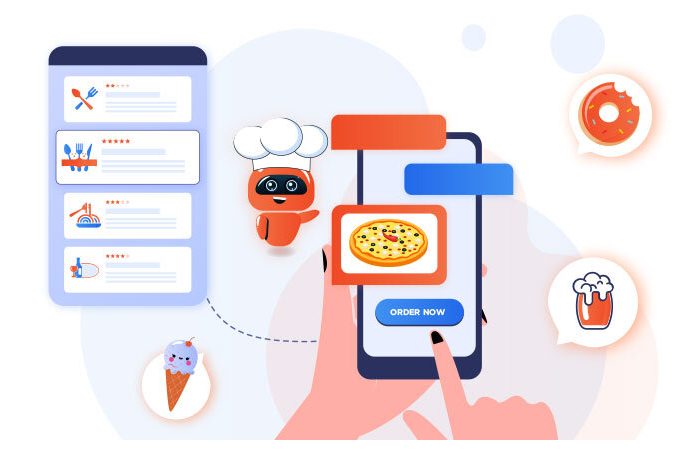Introduction The global dining industry is undergoing a once-in-a-generation transformation. What began as a simple shift toward online reservations and digital menus has now evolved into a full-scale reinvention powered by generative AI. At the center of this transformation is the restaurant agent – an intelligent digital interface that can take orders, recommend dishes, answer
Introduction
The global dining industry is undergoing a once-in-a-generation transformation. What began as a simple shift toward online reservations and digital menus has now evolved into a full-scale reinvention powered by generative AI. At the center of this transformation is the restaurant agent – an intelligent digital interface that can take orders, recommend dishes, answer questions, and even engage customers across multiple channels in real time.
In today’s experience-driven economy, restaurants are not only competing on taste but also on speed, personalization, and convenience. Generative AI is helping them meet these demands by making every interaction smarter, faster, and more human-like.
Technology has been changing the way we live, and the restaurant industry is no exception. The rise of the restaurant chatbot, powered by generative AI, is revolutionizing the way customers interact with eateries. From taking orders to answering questions and managing reservations, these intelligent systems are creating smoother, faster, and more personalized dining experiences.
For restaurant owners, chatbots provide an efficient way to handle customer needs while saving time and reducing errors. This article explores how generative AI is reshaping dining experiences and why chatbots are becoming essential tools in modern restaurants.
The Evolution of Restaurant Technology
Restaurants have been using technology for decades to improve operations, starting with point-of-sale systems and online ordering platforms. Over time, innovations like mobile apps and self-service kiosks have enhanced convenience for diners. The latest wave of innovation comes in the form of generative AI chatbots. Unlike traditional automated systems, these AI-powered chatbots can understand natural language, respond conversationally, and even learn from past interactions to improve service. This makes them more human-like and capable of handling complex customer requests.
Generative AI chatbots are not just tools—they are partners in providing better service. By integrating with reservation systems, menus, and loyalty programs, these chatbots create a seamless and interactive experience that keeps customers engaged and satisfied.
Key Highlights: Why Restaurants Are Betting Big on Generative AI
1. Changing Consumer Expectations
Today’s diners expect immediacy and personalization. They want to browse menus, ask about allergens, reserve tables, and order food from the same chat window at any hour. The modern guest journey has become omnichannel, and AI-driven chat interfaces make it seamless across web, mobile, and social media platforms.
2. Staff Shortages and Cost Pressures
Post-pandemic labor challenges continue to affect the hospitality sector. Rising wages and staff turnover are pushing restaurant owners to automate repetitive interactions without compromising service quality. Generative AI solutions fill this gap — providing consistent, human-like assistance 24/7.
3. Data-Driven Decision Making
Each conversation becomes a source of operational intelligence. From tracking popular dishes to identifying peak ordering hours, chatbot analytics help restaurateurs make data-backed decisions about menus, staffing, and marketing. The data collected also powers personalization, allowing AI systems to suggest relevant dishes or offers based on past orders.
4. Omnichannel Dining Experiences
Whether customers interact via a restaurant website, WhatsApp, or voice assistant, generative AI ensures consistency. By integrating with POS, delivery, and CRM systems, the chatbot can confirm table availability, process takeout orders, and manage loyalty points — all from a single conversational thread.
5. Hyper-Personalized Marketing
Beyond service, conversational AI transforms how restaurants communicate. Chatbots can segment audiences, push timely promotions (like a lunch combo on a rainy day), or even re-engage lapsed customers. Unlike static ads, chat-based marketing feels natural and interactive — leading to higher conversion rates.
Business Benefits: From Engagement to Efficiency
1. Always-On Guest Service
Restaurants no longer need to rely on phone calls or manual reservation books. AI-powered chat interfaces handle inquiries, reservations, and feedback around the clock. For guests, it feels like talking to a responsive human assistant. For staff, it means more time to focus on in-person hospitality.
2. Faster Order Processing
Integrated systems enable real-time order tracking, automated confirmations, and upsell suggestions during checkout. Whether it’s recommending a dessert that pairs with a main dish or highlights a limited-time offer, generative AI drives incremental revenue effortlessly.
3. Reduced Operational Load
Front-of-house teams often juggle phone calls, walk-ins, and delivery of coordination simultaneously. Chatbots can handle the bulk of digital interactions, minimizing errors and freeing human staff to manage guest experiences that truly require empathy and nuance.
4. Improved Guest Retention
Personalized communication doesn’t end when dinner leaves the restaurant. Follow-up messages thanking guests, requesting feedback, or offering loyalty rewards can be fully automated. Over time, this builds brand recall and customer loyalty, two of the most valuable assets in hospitality.
5. Real-Time Insights and Predictive Analytics
Generative AI tools can analyze conversational trends to predict customer demand, highlight supply bottlenecks, or forecast menu performance. By acting on these insights, restaurants can optimize procurement, reduce waste, and enhance profitability.
How Restaurant Chatbots Improve Customer Service
One of the biggest advantages of AI-powered chatbots is their ability to enhance customer service. Here are several ways they do this:
- Instant Responses: Customers no longer need to wait on hold or scroll through long FAQ pages. Chatbots can provide instant answers to questions about menu items, ingredients, dietary restrictions, and more. This improves the customer experience and reduces frustration.
- Personalized Recommendations: Using AI, chatbots can analyze customer preferences and past orders to suggest dishes they might enjoy. For example, a frequent pasta lover might be recommended a new pasta dish or a seasonal special. Personalization creates a more engaging and satisfying dining experience.
- Order Accuracy: Miscommunication in restaurants can lead to incorrect orders. Chatbots reduce human errors by taking clear and precise orders directly from the customer. This ensures that kitchens receive accurate instructions, minimizing mistakes and improving efficiency.
- Reservation Management: Managing reservations can be time-consuming for staff. Chatbots can handle booking requests, confirm availability, and even send reminders to customers. This automation allows staff to focus on providing better in-person service.
Benefits for Restaurant Owners
Restaurant chatbots offer many advantages for both customers and businesses. They can take orders 24/7, reducing wait times and improving service. Chatbots also provide personalized recommendations based on customer preferences, helping increase sales.
They save staff time by handling repetitive tasks like answering FAQs, booking tables, or sending order updates. Using AI, chatbots can understand natural language, making interactions smooth and human-like. For restaurants, this means happier customers, better efficiency, and opportunities to grow revenue.
While chatbots enhance the customer experience, they also provide significant benefits for restaurant owners:
- Cost Efficiency: AI chatbots reduce the need for additional staff to handle customer queries and reservations, lowering labor costs.
- Data Insights: Chatbots collect valuable data about customer preferences, peak hours, and popular menu items, helping owners make informed business decisions.
- Scalability: Whether a restaurant serves 50 or 500 customers a day, chatbots can handle a large volume of interactions without getting overwhelmed.
- Marketing Opportunities: Chatbots can promote special offers, seasonal menus, or events directly to customers, increasing engagement and revenue.
By automating routine tasks, restaurant owners can focus on strategic improvements and enhancing the overall dining experience.
The Role of Generative AI in Enhancing Interactions
Generative AI enables chatbots to understand and respond to complex customer queries in a natural way. Unlike rule-based bots, which can only handle predefined commands, generative AI can generate context-aware responses that feel human-like. For example, if a customer asks, “I have a peanut allergy; what can I safely eat?”, a generative AI chatbot can provide detailed suggestions and even recommend modifications to menu items.
This level of intelligence allows restaurants to provide high-quality service around the clock. Chatbots can operate 24/7, answering questions, accepting orders, or assisting with reservations outside regular business hours. This increases accessibility for customers and enhances brand reputation.
Real-World Applications in Restaurants
Many restaurants and chains are already implementing AI chatbots with great success. Some of the most common uses include:
- Online Ordering: Customers can place orders through a chatbot on a website or mobile app. The bot can guide users step-by-step and confirm orders in real-time.
- Customer Feedback: Chatbots can collect reviews and feedback immediately after a meal, allowing restaurants to respond quickly and improve service.
- Event Planning: Restaurants hosting events can use chatbots to manage guest lists, dietary preferences, and special requests.
- Loyalty Programs: Chatbots can remind customers of loyalty points, suggest rewards, and encourage repeat visits.
These applications show how versatile chatbots are in improving operations and enhancing customer satisfaction.
Challenges and Considerations
Despite their benefits, restaurant chatbots face some challenges. Some customers prefer speaking to real people and may feel frustrated with automated responses. Chatbots may also struggle with complex orders or unusual requests. Implementing and maintaining a chatbot requires investment in technology and training, which can be difficult for smaller restaurants.
Data privacy and security are also important concerns, as chatbots collect customer information. However, with proper design and continuous improvement, most of these challenges can be managed effectively.
While restaurant chatbots offer many benefits, there are some challenges to consider:
- Technical Limitations: AI chatbots are only as good as the data they are trained on. Inaccurate information can lead to incorrect responses.
- Customer Adaptation: Some customers may prefer speaking to a human, especially for complex issues or complaints. A hybrid approach, where AI handles routine tasks and humans handle exceptions, is often the best solution.
- Privacy Concerns: Chatbots collect personal information, which must be managed carefully to protect customer privacy and comply with regulations.
Despite these challenges, careful planning and implementation can maximize the advantages of restaurant chatbots.
The Future of Dining Experiences
The future of restaurant chatbots looks very promising. As AI technology continues to improve, chatbots will become smarter, more conversational, and even more capable of handling complex tasks. They may integrate with other technologies like voice assistants, AR menus, or loyalty programs.
Restaurants will be able to offer highly personalized dining experiences, predict customer preferences, and optimize operations more efficiently. Generative AI will continue reshaping the dining industry, making chatbots an essential tool for customer engagement and business growth in the years ahead.
The rise of restaurant chatbots signals a larger trend: the integration of AI into everyday experiences. In the future, we can expect even more advanced features, such as:
- Voice-Activated Ordering: Chatbots that understand spoken commands for hands-free interaction.
- Predictive Suggestions: AI predicting what a customer might want based on time, weather, or past behavior.
- Enhanced Personalization: Bots offering tailored dining experiences, including menu customization and exclusive deals.
- Integration with Smart Devices: AI chatbots connecting with smart home devices for seamless ordering and delivery.
As generative AI continues to evolve, dining experiences will become increasingly interactive, efficient, and personalized.
A Strategic Imperative, Not Just a Tech Trend
The adoption of conversational AI in hospitality is no longer experimental it’s strategic. Diners now expect smooth digital interactions as much as they expect good food. Restaurants that treat AI as an integral part of the guest experience will thrive in this new landscape.
Ultimately, the smart pre-trained restaurant chatbot represents more than automation; it symbolizes the fusion of hospitality and intelligence. The restaurants embracing it today are not just digitizing service they are redefining what it means to create memorable, data-driven, and deeply personal dining experiences.
The future of dining is conversational, and those who master the dialogue will own the customer relationship.
Conclusion: AI Chatbots Are Changing the Way We Dine
Restaurant chatbots powered by generative AI are transforming the dining landscape by enhancing customer service, improving operational efficiency, and creating more personalized experiences. They allow restaurants to provide fast, accurate, and 24/7 support while giving owners valuable insights and cost savings. While challenges like technical limitations and customer adaptation exist, the benefits clearly outweigh the drawbacks.
As AI technology advances, chatbots will play an even bigger role in shaping how we order, interact, and enjoy meals. For customers and restaurant owners alike, the rise of the restaurant chatbot is not just a technological trend—it’s a step toward smarter, more connected, and enjoyable dining experiences.
















